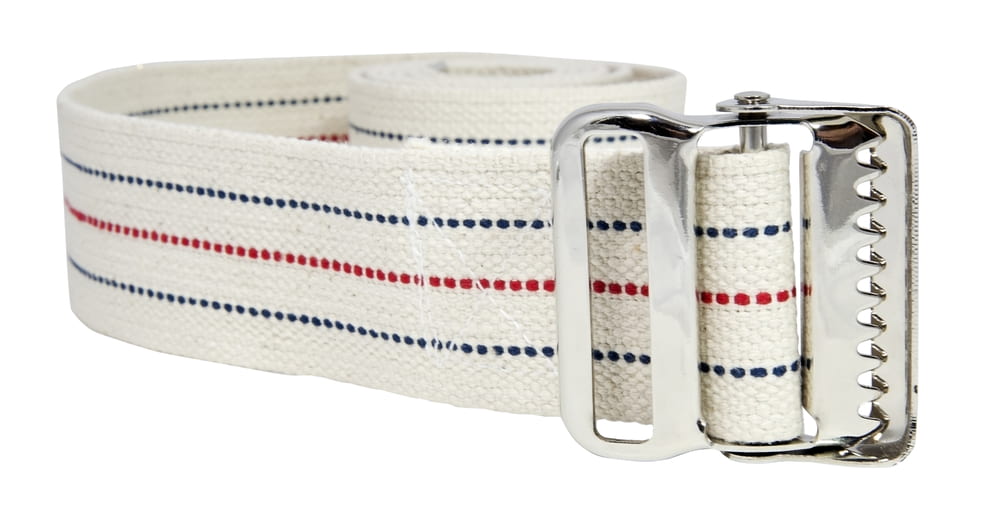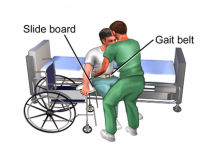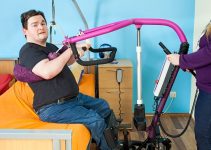If you or your caretaker want to have an extra safety-net when walking or transferring, a gait belt (also called patient transfer belt) is your best bet.

By providing a point of contact, it helps keep the user stable and lessens tears on their clothing, as well as preventing bodily harm. In short, they keep both the caregiver and receiver safe.
In this article, We will review the 6 best transfer belts on the market. There are the top 3 in case you are in a hurry:
#Affiliate links.Last update on 2024-04-17 at 04:33
Reviews of the Best Patient Transfer Belts
1. Vive Transfer Belt With Handles—Best Overall
#Affiliate links.Last update on 2024-04-17 at 04:33
This belt is made from nylon and comes with six padded handles that fasten to the belt with reinforced stitching.
Vive advertises the handles as allowing for assistance at any angle. Nurses and physical therapists use the belt because of how easy it is to grab and control movements when someone is losing their balance.
It also has a metal buckle with locking teeth which prevents the 55-inch (140 cm) belt from loosening. As for measurements, it suits people with a waist size up to 51 inches (130 cm).
This belt is sturdy and stable, especially the handles. What’s not as popular is that the teeth on this belt are difficult to tighten. The handles are too large for some users.
Pros
- Several padded handles.
- Easy to grab and control movements.
- Feels sturdy.
Cons
- Metal buckle is hard to use.
- Loops are too large.
2. Secure SGBM-60S Patient Transfer and Walking Gait Belt—Best Budget Option
#Affiliate links.Last update on 2024-04-17 at 04:33
For an affordable price, you get this 60-inch (152 cm) belt that’s available in four unique colors: beige, camo, leopard, and yellow. It also has a metal buckle that’s secured with tight stitching.
The Secure belt is 100 percent cotton which makes it both comfortable and machine-wash friendly. Users feel like this build is sturdy and report that the belt doesn’t curl up on the edges.
However, some state that it’s challenging to readjust the belt’s length while using this buckle. It’s not user-friendly and doesn’t come with proper instructions for handling.
Also, this belt only has one loop for gripping, making it less flexible than belts with more handles.
Pros
- Budget-friendly.
- Four unique designs.
- Comfortable cotton material that doesn’t curl.
Cons
- Buckle is challenging to use.
- Only has one handle for gripping.
3. Vive Gait Belt with Metal Buckle—Most Supportive
#Affiliate links.Last update on 2024-04-17 at 04:33
The greatest thing with this gait belt from Vive is that it supports up to 500 pounds (227 kg). It’s also a long band—60 inches (152 cm) which means that you can use it for patients with up to a 56-inch waist.
This belt is cotton which makes it comfortable. Plus, it’s easy to buckle and unbuckle.
But, the cotton webbing rubs on the sharp edges of the metal buckle, which can unravel the belt slowly. Some elderly customers could use it for a few months without problems, but then it started fraying. The stitching isn’t the best quality.
Pros
- Supports heavier weights.
- Easy to buckle.
- Comfortable cotton fabric.
Cons
- Belt unravels after some time.
- Stitching is poor.
4. Secure Transfer Gait Belt with Handles and Quick Release Buckle—Best Quick-Release
#Affiliate links.Last update on 2024-04-17 at 04:33
Secure’s gait belt has a plastic quick-release buckle that allows for fast attaching and detaching from the user. You don’t have to readjust the belt every time you use it, making the belt super convenient.
The downfall with its plastic buckle is that it’s not that long-lasting. It may stop working after a few months, and the material feels cheap.
This transfer belt has a nylon body that isn’t the most comfortable material, but we like that it has padding inside for added comfort. However, the nylon body is prone to slipping.
One added plus is that the belt has several loops that provide more flexible gripping options.
Pros
- Attaches and detaches quickly.
- Soft extra padding.
- Has several handles.
Cons
- Not very durable.
- Slips rather easily.
5. ACTIF DLX Transfer Belt With Handles—Most Comfortable
#Affiliate links.Last update on 2024-04-17 at 04:33
Actif has created this lift belt for the elderly with a generous 4.7-inch (12 cm) width. This prevents the belt from digging into the body and makes it comfortable.
Another plus is that it comes with seven soft handles that are both horizontal and vertical, which allows for versatile gripping. The belt has a non-slip lining, and it feels like it sticks to your clothing.
For the cons, this belt is smaller than some people expected, so doesn’t fit bigger people. Also, the plastic clasp easily pops open, and even broke for some users.
Pros
- Wide belt adds more comfort.
- Seven handles for both horizontal and vertical gripping.
- Non-slip lining.
Cons
- Small in size.
- Flimsy plastic buckle.
6. Kavil Transfer Belt with Handles—Best Gait Vest with Handles
#Affiliate links.Last update on 2024-04-17 at 04:33
While labeled as a transfer belt, this is more of a gait vest with shoulder straps that go around the user’s whole torso. It has a whopping eight handles that are both horizontal and vertical. Kavil states that this allows the caregiver to disperse pressure and handle more weight.
We like the fact that this vest is so easy to use. The quick-release plastic buckles make it exceptionally convenient.
However, the vest is nylon which gets hot easily. There are also customers that experience problems with the thin shoulder straps and fragility of the plastic buckles.
Pros
- A vest allows the caregiver to handle more weight.
- Eight handles spread out over the vets.
- Easy to use.
Cons
- The vest builds up heat.
- Shoulder straps and buckles aren’t the best quality.
Things To Consider When Buying Gait Belts
Caregivers use gait belts for the following purposes:
- To provide a point of contact that can help control a user’s descent if they lose their balance.
- Reduce tears on the patient’s clothing or scratches and bruising on their body during transfer.
- Help to make the user feel safe when walking or transferring. (If you want to transfer a patient from bed to chair, a transfer board comes in handy.)
For belts to be durable, secure, and supportive, they should have the following features:
Clasp Type
A gait belt with a metal buckle has less risk of coming undone since its strong teeth grip each other tightly. They’re also more durable.
Plastic clasp belts can be released quickly which can be an advantage in terms of comfort for the user and time saving. However they’re less robust.
In general, metal clasps are better, as a safe, secure fastening should be essential in gait belts.
Handles
You can find belts without them, but the best gait belts have handles. These provide easier access for the caregiver. Handles with padding also give better control and grip, making for a safer transfer.
Typically, the more handles, the better since this makes the belt more versatile and allows the caregiver to efficiently support the belt user in a variety of positions.
But ensure that the stitching on the handles or loops is high-quality. If it’s loose or appears damaged, don’t use the handle.
Materials
The next thing to consider is the material of the belt. Typically, it’s cotton or a synthetic such as vinyl or nylon, or a mixture of both.
Synthetics tend to slip on the skin. They don’t absorb moisture well, increase sweating, and don’t hold in place firmly when the skin is wet, say, after a shower. However, they’re easier to wipe off than cotton ones..
In comparison, cotton belts absorb moisture such as sweat and prevent slippage, making them superior. Skin-irritation is also less with these belts. Furthermore, they’re machine wash-friendly.
Measurements
Patient transfer belts are generally between 54-60 inches (137-152 cm) long and 1.5-4 inches (4-10 cm) wide. As long as they fasten when around the user’s hips, the length is appropriate.
Note that you should always tuck any excess length back into the belt after fastening it to keep it from dangling.
What’s most important in terms of the user’s measurements is their weight. Before you buy a patient transfer belt for yourself or a patient, you need to be sure that it supports the user’s weight. Most belts can support between 300-500 pounds (136-227 kg).
FAQ’s
How Do You Transfer a Patient Through a Gait Belt?
First, follow these steps to help the user stand up:
- Make sure the patient is in a sitting position and fasten the gait belt around their waist.
- Face the patient standing up with your feet apart, knees bent, and a straight back. Then, grasp the gait or its handles firmly on both sides.
- Tell the patient you’ll be counting down from three and ask them to help stand up if their mobility allows for this.
- Straighten your knees and lift the patient to a standing position on the count.
- Tighten the belt as needed.
Now, help them walk by following these steps:
- Stand on the weaker side of the patient slightly behind them.
- Place one hand under the belt at the center of the patient’s back, your palm facing you.
- Walk hip-to-hip with the patient, using the belt to control movement.
When Should You Not Use a Gait Belt?
The US Occupational Safety and Health Administration recommends caregivers avoid manual lifting as much as possible. But if this is absolutely necessary, you will need alternative equipment.
You shouldn’t use a gait belt to lift or carry a person by the waist. This can hurt the caregiver’s back and increase the risk that the wearer will fall. They’re designed to support the user and lessen the impact from falls, not carry them.
Summing Up
Transfer belts provide caregivers with a way to securely and safely support a patient that’s unstable on their feet.
After reviewing the best six patient transfer belts, our favorite is the Vive Transfer Belt With Handles. It’s equipped with a durable metal buckle, six sturdy handles with reinforced stitching, and professional caregivers recommend their use.
If you’re looking for a cheaper alternative, go for the Secure SGBM-60S Patient Transfer and Walking Gait Belt. This belt comes in colorful designs, is made from comfortable cotton, and has a long-lasting metal clasp.
But which gait belt suits you the best?









